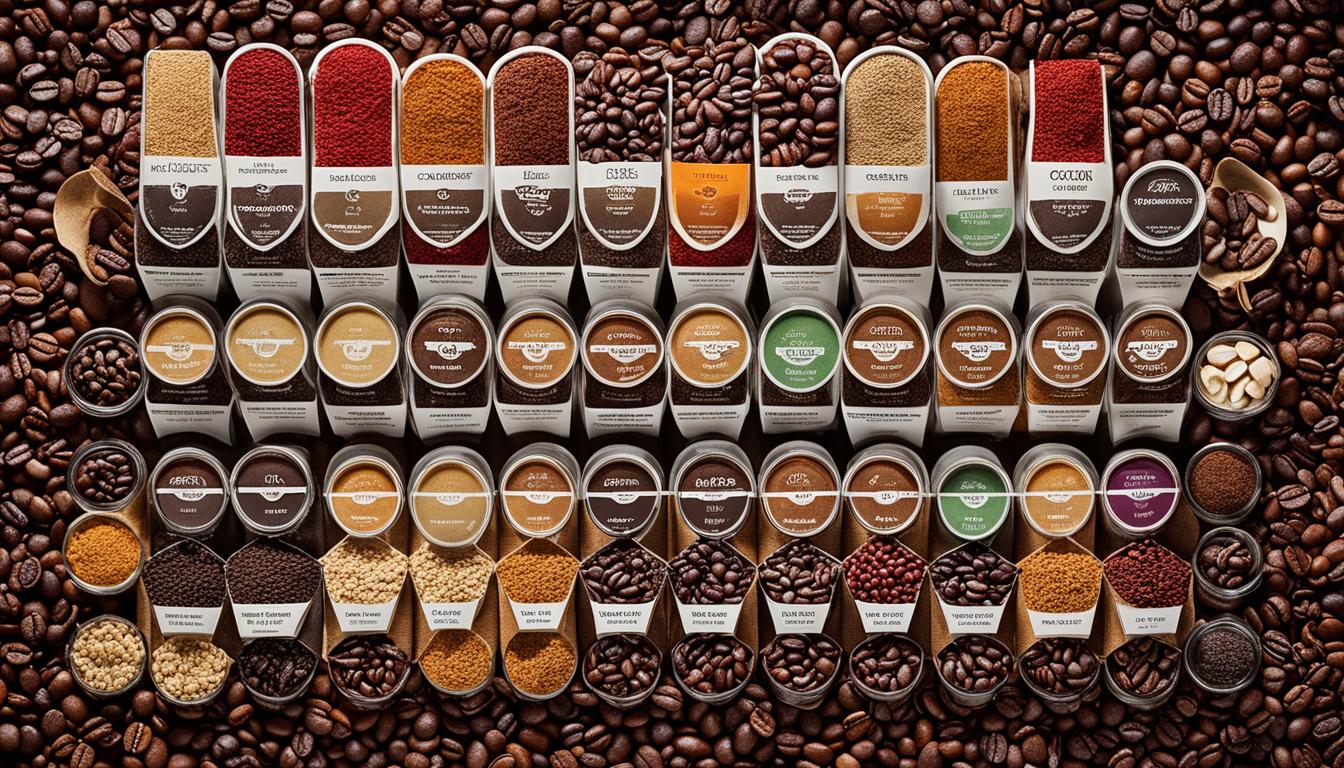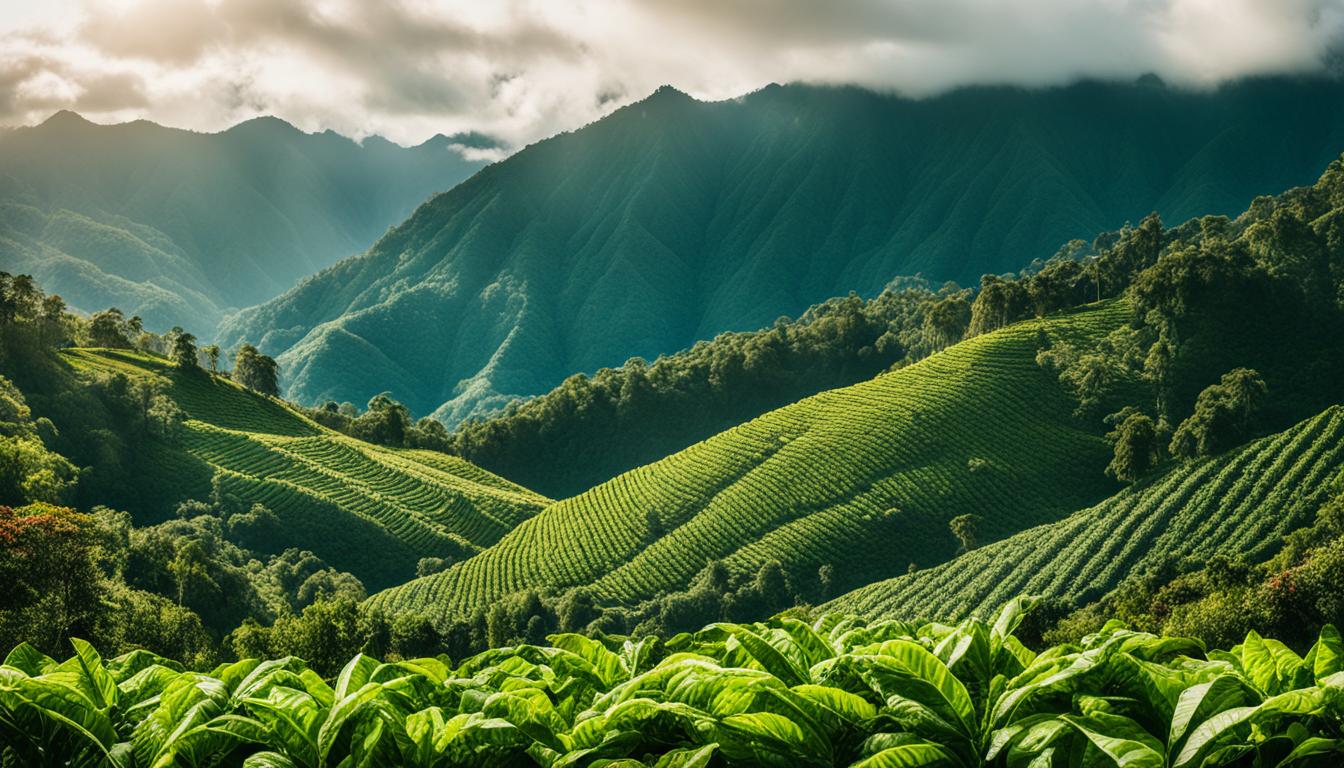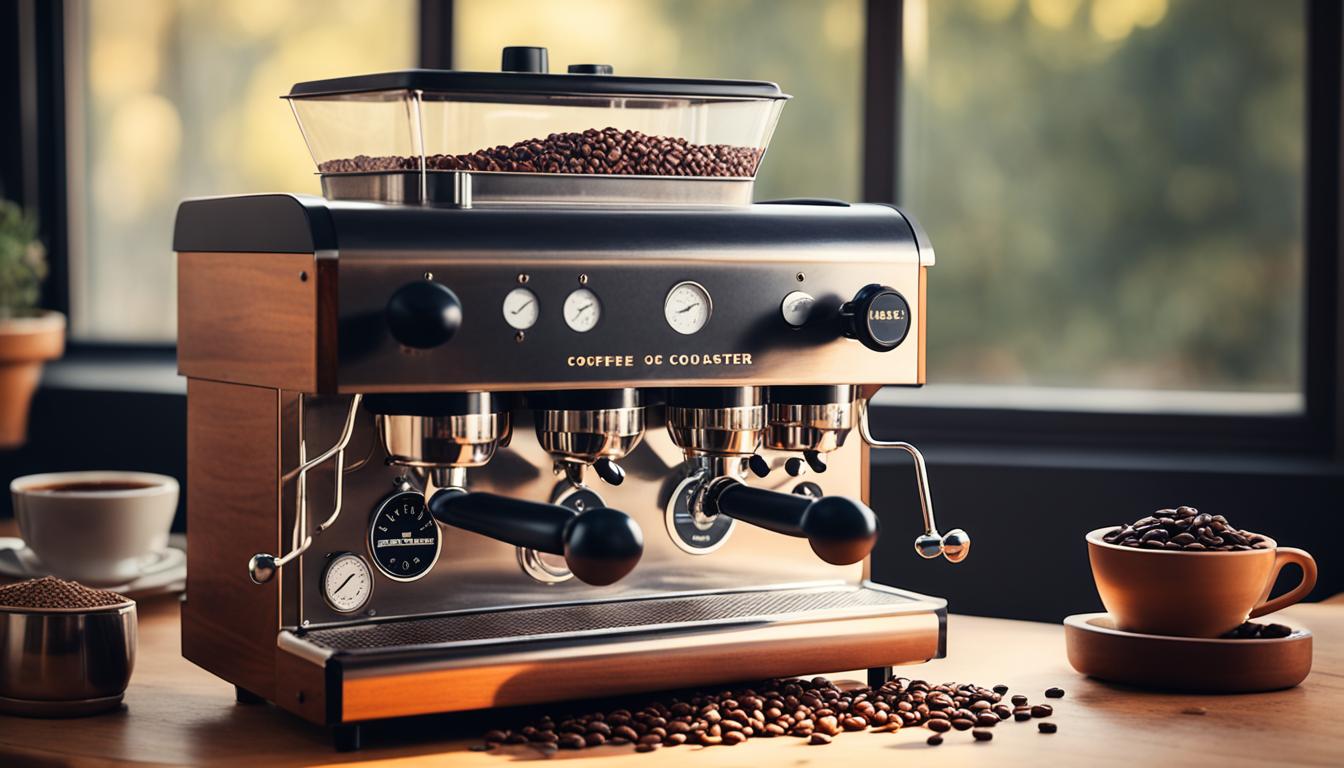Welcome to our guide on blended coffees! Are you ready to dive into the world of artisanal coffee blends and explore the exquisite flavor profiles they offer? In this article, we will take a deep dive into the blending process and unravel the secrets behind creating unique and delicious coffee blends that will satisfy even the most discerning coffee connoisseurs.
Blended coffees are a true art form, crafted by expert roasters and baristas who understand the nuances of coffee flavor profiles. By combining different types of coffee beans, mastering the roasting process, and considering various factors, like the origin and freshness of the beans, these professionals create blends that tantalize our taste buds and offer a truly exceptional coffee experience.
Whether you’re a coffee enthusiast eager to experiment with your own coffee blends or a coffee lover who simply enjoys a reliable and consistent cup of joe, understanding the mix and flavors of blended coffees is essential. Get ready to unlock the secrets behind creating your own unique and delicious coffee blends!
Key Takeaways:
- Artisanal coffee blends offer unique and exquisite flavor profiles.
- Understanding the blending process is key to crafting exceptional coffee blends.
- Coffee flavor profiles are determined by the type of beans, roasting techniques, and other factors.
- Different beans, like Arabica and Robusta, contribute distinct flavors to blended coffees.
- The roasting strength and freshness of coffee beans significantly impact the final flavor.
The Role of Coffee Beans in Flavor Profiles
When it comes to crafting the perfect cup of coffee, the choice of coffee beans plays a crucial role in determining the flavor profiles of blended coffees. Different types of coffee beans, such as Arabica and Robusta, offer distinct characteristics that contribute to the overall taste experience.
Arabica Beans: Often regarded as the superior choice for specialty blends, Arabica beans bring a delightful sweetness, softness, and vibrancy to the cup. They are known for their complex flavor profiles, which can include notes of fruits, nuts, and chocolates. With their delicate aroma and nuanced taste, Arabica beans are a popular choice among coffee enthusiasts seeking a refined and flavorful blend.
Robusta Beans: On the other hand, Robusta beans are known for their boldness and full-bodied nature. They provide a robust and rich flavor experience, often characterized by earthy, nutty, and bitter notes. Robusta beans are valued for their higher caffeine content and ability to enhance crema, making them a favored choice for espresso blends.
The flavor profiles of blended coffees are not solely determined by the types of coffee beans used, but also influenced by their origin. Central and South American beans are renowned for their delicious flavor notes, while African beans contribute fruity and floral undertones. Asian beans, on the other hand, add intense and distinctive flavors to the blend.
Understanding the characteristics of different coffee beans is essential for crafting expert blends that satisfy the diverse taste preferences of coffee lovers. Whether you prefer the sweetness and vibrancy of Arabica beans or the boldness of Robusta beans, the combination and balance of ingredients will ultimately shape the flavor profile of your cup of coffee.
By studying the role of coffee beans in flavor profiles, we gain insight into the art of blending and the nuances that make each cup of coffee a unique experience. In the next section, we’ll delve into the importance of roasting and freshness in creating the perfect blend.
The Importance of Roasting and Freshness
The roasting and freshness of coffee beans are crucial factors that significantly impact the flavor, aroma, and body of a coffee blend. Understanding these elements is essential for creating the best flavor profiles in blended coffees.
The Roasting Process and Flavor
When coffee beans are roasted, they undergo chemical transformations that develop their unique flavors. Light roasts result in mellow flavors with subtle acidity, while dark roasts yield bolder and more intense flavors. The roasting process enhances different taste characteristics, such as sweetness, chocolate or nuttiness, acidity, and bitterness. Each roast level unveils a distinct flavor profile, allowing coffee enthusiasts to explore a diverse range of taste experiences.

Importance of Freshness
Freshness is a critical aspect of enjoying a flavorful cup of coffee. As time progresses, the flavor compounds in coffee beans gradually degrade, resulting in a loss of aroma and taste. To experience the full potential of coffee’s flavor, it is best to use freshly roasted and ground beans. The fresher the beans, the more pronounced and vibrant their flavor will be.
By paying attention to the roasting strength, origin, and freshness of the coffee beans used in the blending process, we can ensure that our coffee blends deliver the optimal flavor experience for our customers.
Blending Techniques and Factors to Consider
Creating a unique and delicious coffee blend involves a combination of blending techniques and careful considerations. Coffee professionals rely on their expertise to craft signature flavors by selecting the right coffee beans, determining the roasting strength, and striking the perfect balance between soluble and insoluble components. Let’s explore the key factors that contribute to the art of coffee blending.
The Choice and Ratio of Coffee Beans
The first step in creating a remarkable coffee blend is selecting the right beans. Coffee beans from different regions and varieties have distinct flavor profiles, contributing to the overall taste of the blend. Whether you’re using Arabica or Robusta beans, understanding their characteristics and experimenting with different ratios can lead to the desired flavor combination.
The Degree of Roast
Roasting the coffee beans is a critical step that influences the flavor and aroma of the final blend. The degree of roast can range from light to dark, each showcasing unique characteristics. Lighter roasts preserve the vibrant and delicate flavors of the beans, while darker roasts offer a bolder and more intense experience. Finding the perfect roast level for your blend ensures that the flavors harmonize and create a delightful cup of coffee.
The Balance between Soluble and Insoluble Components
Coffee contains both soluble and insoluble components that contribute to its flavor and body. The soluble components dissolve during extraction, providing the desirable flavors of the brew. On the other hand, the insoluble components, such as oils and sediment, add body and mouthfeel. Achieving the right balance between these components is essential in creating a well-rounded and satisfying blend.
Coffee Origin
The origin of the coffee beans also plays a crucial role in determining the flavor profile of a blend. Different regions produce beans with distinct characteristics. For example, Central and South American beans are known for their smoothness and balanced acidity, while African beans offer fruity and floral notes. Asian beans, on the other hand, boast intense and earthy flavors. Understanding the nuances of coffee origin allows for the creation of blends with unique flavor profiles.
“Blending coffee is an art that combines science, creativity, and passion. By experimenting with different blending techniques and considering these important factors, we can create coffee blends that satisfy our palates and bring joy to every sip.”
Overall, mastering the art of coffee blending requires an understanding of blending techniques, the selection of coffee beans, the degree of roast, and the balance between soluble and insoluble components. Acknowledging the influence of coffee origin adds an extra layer of complexity and opportunities for creating unique flavors. Building on these foundations, coffee professionals and enthusiasts can continue to refine their craft and delight in the creation of remarkable coffee blends.
Conclusion
Blended coffees offer a unique and flavorful experience, with each blend showcasing its own distinct flavor profile. By understanding the role of coffee beans, the importance of roasting and freshness, and the blending techniques and factors to consider, you can create delicious and one-of-a-kind coffee blends.
Whether you’re a coffee aficionado looking to craft your own blends or a coffee drinker seeking a reliable and consistent cup of coffee, understanding the mix and flavors of blended coffees is essential. Experiment with different coffee beans and roasting techniques to create the perfect flavor profiles that suit your taste preferences.
Delve into the world of coffee blends and discover the variety of unique flavor combinations that await you. From rich and chocolatey to bright and fruity, blended coffees offer endless possibilities for your taste buds to explore. So go ahead, grab your coffee grinder, select your favorite coffee beans, and embark on a journey to create your own unique blends.
FAQ
What is the role of coffee beans in flavor profiles?
Coffee beans, such as Arabica and Robusta, contribute to the flavor profiles of blended coffees. Arabica beans are sweeter and softer, while Robusta beans are bolder and provide a full-bodied cup of coffee. Different coffee origins also add distinct flavor notes.
How does roasting and freshness affect the flavor of coffee blends?
Roasting coffee beans affects the flavor, aroma, and body of the coffee blend. Light roasts have mellow flavors, while darker roasts are bolder and more intense. Freshness is crucial for maximum flavor in a cup of coffee.
What factors should I consider when blending coffee?
When blending coffee, it’s important to consider the choice and ratio of coffee beans, the degree of roast, and the balance between soluble and insoluble components. Coffee origin and roasting strength also play a role in creating the desired flavor profile.
Can I create my own unique coffee blend?
Yes, by experimenting with various blending techniques and considering factors such as coffee bean type, roasting strength, and balance of components, you can create your own delicious and unique coffee blends.
Why should I explore blended coffees?
Blended coffees offer a unique and flavorful experience. Each blend has its own distinct flavor profile, allowing you to discover your perfect cup of coffee. Exploring blended coffees allows you to enjoy a wide range of flavors and find the blends that suit your taste preferences.




